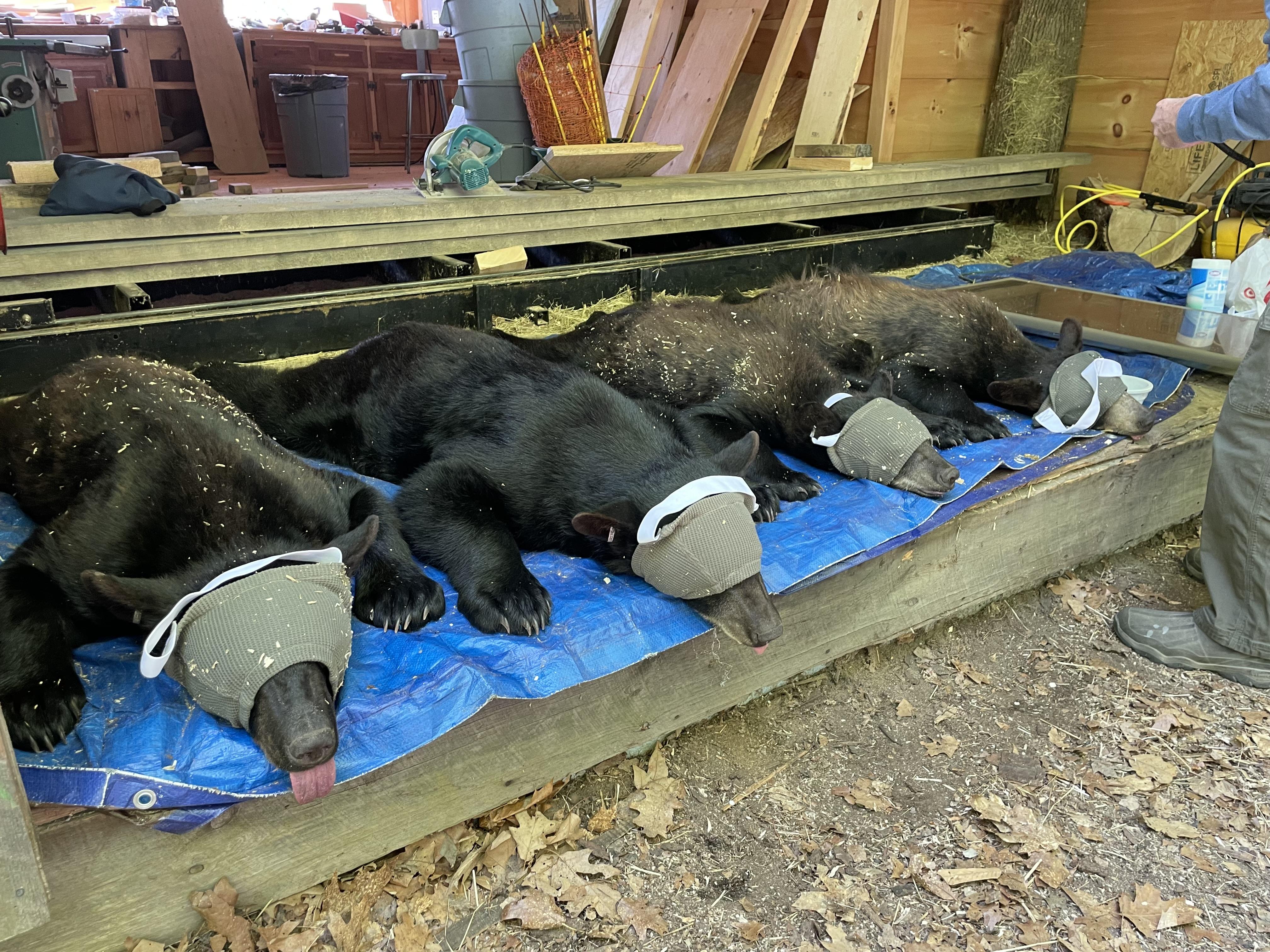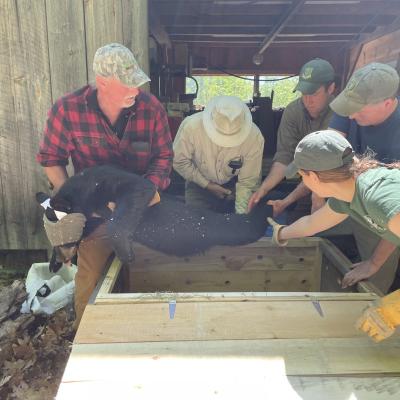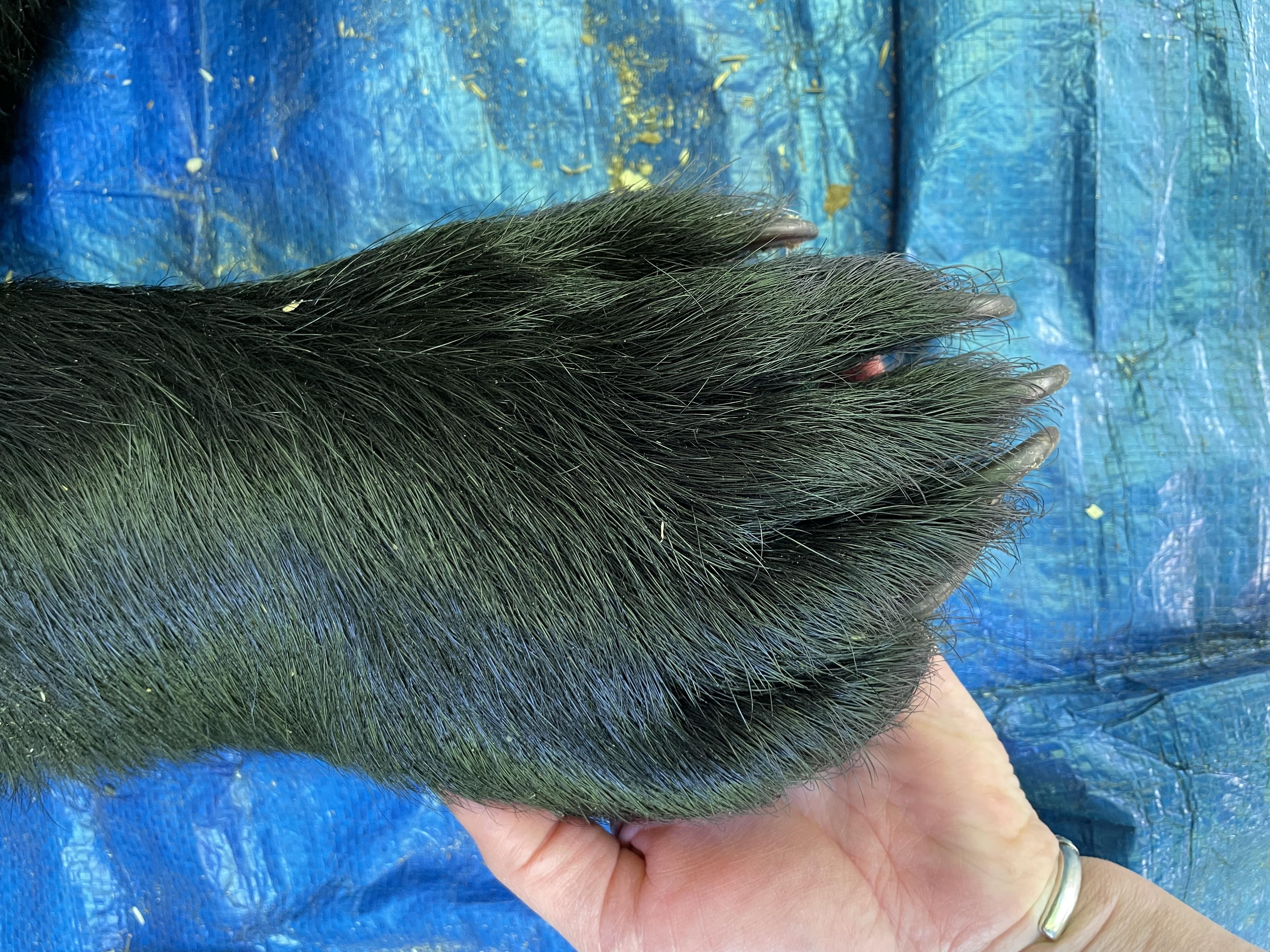Fattened up over the winter at the Kilham Bear Center, a record class of yearling bears is sent out on their own.
- Tags:
- Wildlife

Ready to disperse onto conserved forestland in NH. Photos by Emily McGee Anderson

Rehabilitated orphan yearling bears have moved-out of the Kilham Bear Center to large blocks of conserved rural forestland in locations far from human habitation. Experienced volunteers served as Uber drivers – giving bears rides back home to forested tracts of conservation land that will give these bears their best chance of success for survival in the wild.
Lyme, NH bear rehabilitator Ben Kilham explains how black bears are fundamentally forest- dependent, superbly adapted to living in remote landscapes. Bears are cover dependent. Under normal circumstances, they avoid moving during daylight hours after leaf-off in late autumn and before leaf-out and green-up in late spring. June is the most critical month for seeking food and is also the mating season for mature bears. Bear sightings spike each June.
Recurring boom and bust cycles impact availability of autumn foods essential to feed and fatten cubs after females’ milk dries up in late summer. In autumn 2022, the Northeast region again experienced conditions reminiscent of the so-called “Great squirrel apocalypse” in 2018 when a shortage of natural foods - acorns, beechnuts and wild apples - drove sows with cubs from core territories in search of food. By spring 2019, the Kilham Bear Center had fed and released approximately 75 cubs that volunteers helped to release in NH and VT.
An Unprecedented Increase
Fast forward to spring 2023 when orphans total more than 150, an unprecedented 100% increase over 2019. The bears, now yearlings, spent winter fattening on dog kibble, apples and crimped corn to comfortably sleep inside artificial wooden den boxes at the rehab facility with minimal contact with humans. Underweight rescued cubs arrived weighing between 10 and 15 pounds. A first year cub normally weighs between 35 and 40 pounds. Kilham’s goal was to fatten cubs while keeping them wild in preparation for release this spring.
Kilham says after release, yearling bears immediate priority is to seek concealment cover, disperse from release sites and to find food and water. Kilham relates how released cubs almost immediately begin feeding on spring-green vegetation: emerging leaves and tender grasses and ferns, a salad bar diet normally augmented by leftover acorns or beechnuts called “hard mast” by wildlife biologists. The nuts remain palatable until they sprout in spring.
According to Andrew Timmins, Game Programs Supervisor for the NHFG Game Division and former NH Bear Biologist “spring is always a lean time for bears trying to restock body fat they lost during their denning period. Bears leaving hibernation have body weights depleted by 30% to 50% of body fat that sustains them. The situation is most difficult for nursing sows emerging with newborn cubs.”

Road kills are beyond the control of wildlife authorities. The other leading causes of bear mortality resulting in orphans is when female bears are killed by homeowners due to conflicts or when sows with dependent cubs are killed by bear hunters during the autumn hunt. “People make decisions based on a lack of knowledge, intolerance and for reasons related to their beliefs or opinions.” NHFG seeks to avoid any increase the number of cubs requiring intervention and rehabilitation. But Timmins adds “we struggle to change human behaviors which create a need to rehabilitate underweight bears and fuel the public expectation that authorities will do so. The future of NH’s bear population depends on increasing public support and tolerance for bears.”
Education programs to change human behaviors include recommended best practices for avoiding bear conflicts: remove birdfeeders, secure trash and garbage, use electric fences to protect increasingly popular backyard poultry and give bears space when a female seeks to reunite with a cub seemingly stranded in a backyard tree.
Let Nature Take Its Course?
To those who suggest authorities simply “allow nature to take its course,” Timmins is careful: “The decision to rehabilitate bears is complex. We recognize people hold varied opinions on this practice. Given the fact that there is a long history in NH and elsewhere of rehabilitating a host of species: deer, moose, bobcats, raptors, baby birds - the question shouldn’t be specific to one species. Personally, I struggle with the philosophy of ‘let nature take its course’ because there is nothing natural about the factors that drive a need for rehabilitation. Adult bear survival is generally high. Bears are not prone to diseases or other natural mortality events.” Timmins adds “leaving orphan cubs to starve in backyards does not increase public appreciation for wildlife and doesn’t bolster public support for the wildlife management mission of NHFG.”

The Question of Carrying Capacity?
Some people question if the current bear population has reached maximum carrying capacity. The NH bear population is now estimated to be 6,300 bears statewide – an 8% decline from 6,800 two years ago. In this context, the 150 orphan cubs rescued this past winter represent a little over 2% of the statewide population. The practice of bear rehabilitation does not achieve a population level impact.
Timmins explains “NH has not exceeded biological carrying capacity. Current bear populations are consistent with goals set by the public in four management regions and higher than goal in two regions.” It is harder to measure social or political carrying capacity. “If you assume that carrying capacity is represented by population goals set by the public, perhaps we have reached that level in two of the six management regions but not in the majority of the state. People base their opinion of what the bear population is doing on the number of bears they see in a given summer. Bears move and congregate at food sources, therefore fixing carrying capacity on the rate of bear sightings in a given year is a poor tool for measuring regional bear density. It’s biologically impossible for bear populations to increase or decrease that substantially from one year to the next.”
Timmins relates how cubs have no social status in the matriarchal hierarchy of the bear population. Bears only have access to food based on mother sow's status. Once orphaned, cubs gravitate to readily available food opportunities. Adult bears avoid developed areas because of high risks. Underweight 20-25 pound cubs are forced to exploit these areas to survive because they are vacant. In abundant food years, this is less an issue as cubs are large enough to survive on their own. It only becomes an issue when undersized cubs have limited abilities to survive. The numbered ear tags affixed to the now-well-fed 50-pound yearlings released from the Kilham Bear Center indicate released cubs do not appear disproportionately among subsequent captures. In fact, ear tags indicate successful survival for released bears over years after release.
Some people question the wisdom of releasing bears back into forests lean on natural foods this time of year. The forecast for fall food crops is uncertain. Yearlings may not stay where they are initially released. Yet consider how people who found cubs last autumn and winter expected wildlife authorities and The Kilham Bear Center to save them from starvation and certain death.
Yearlings are ready to go back to the woods. Large, remote tracts of permanently conserved forestland provide the best opportunities for their future success. Let’s give them the chance to live happily ever after in a NH forest.
- Learn more about the Kilham Bear Center here: https://kilhambearcenter.org/
